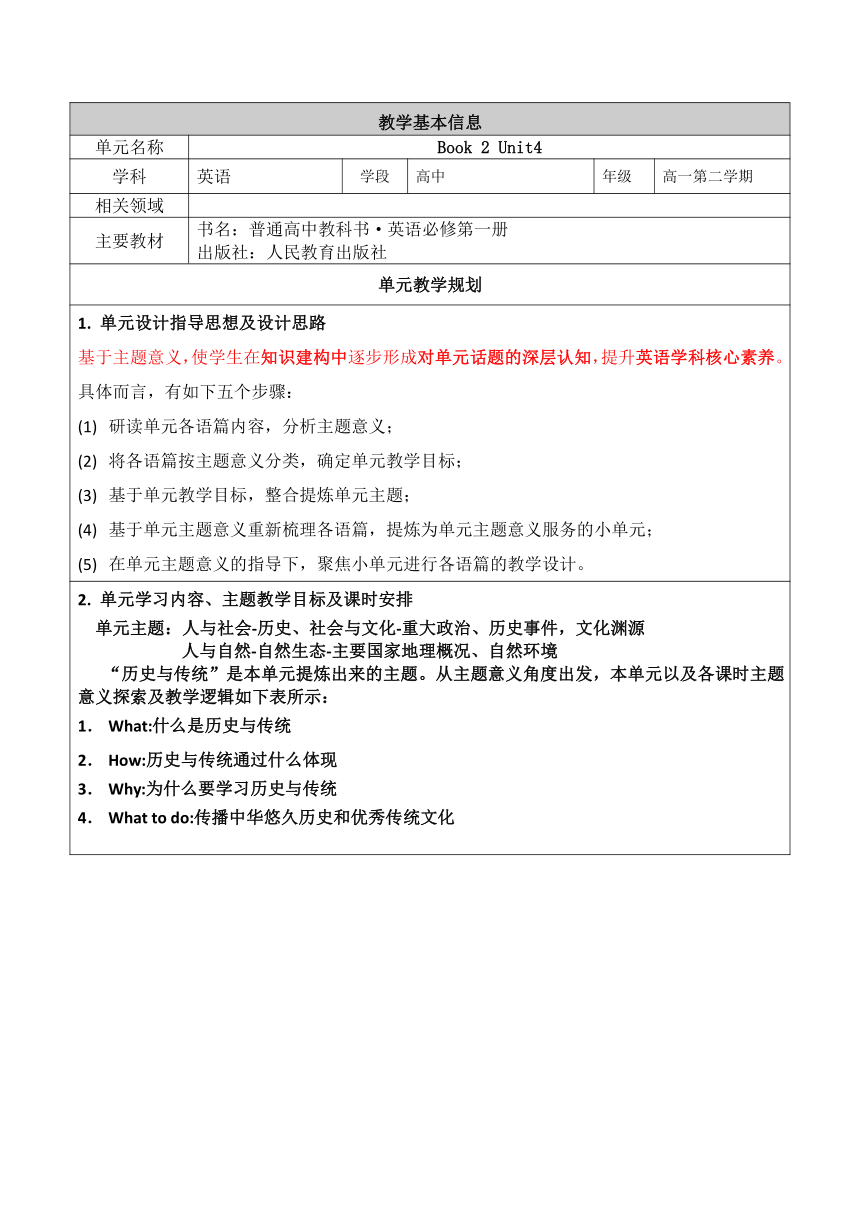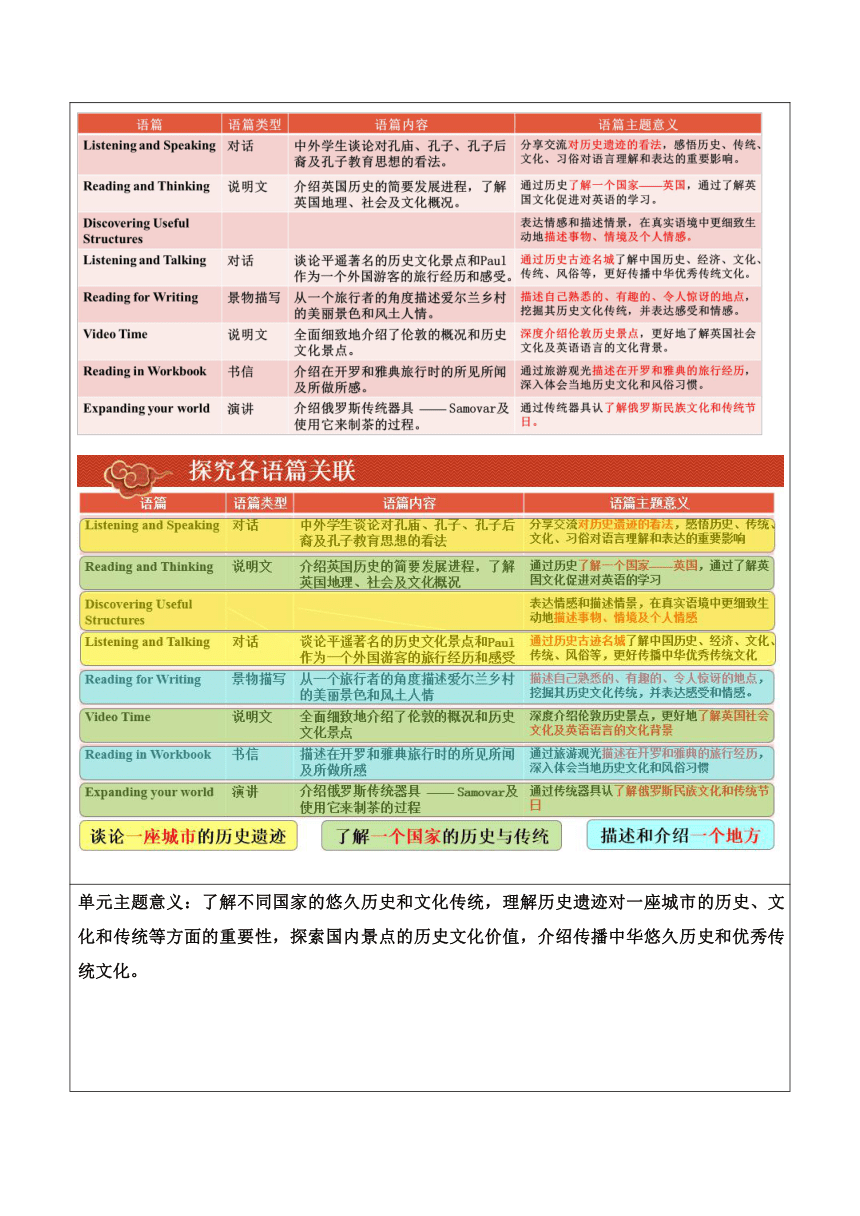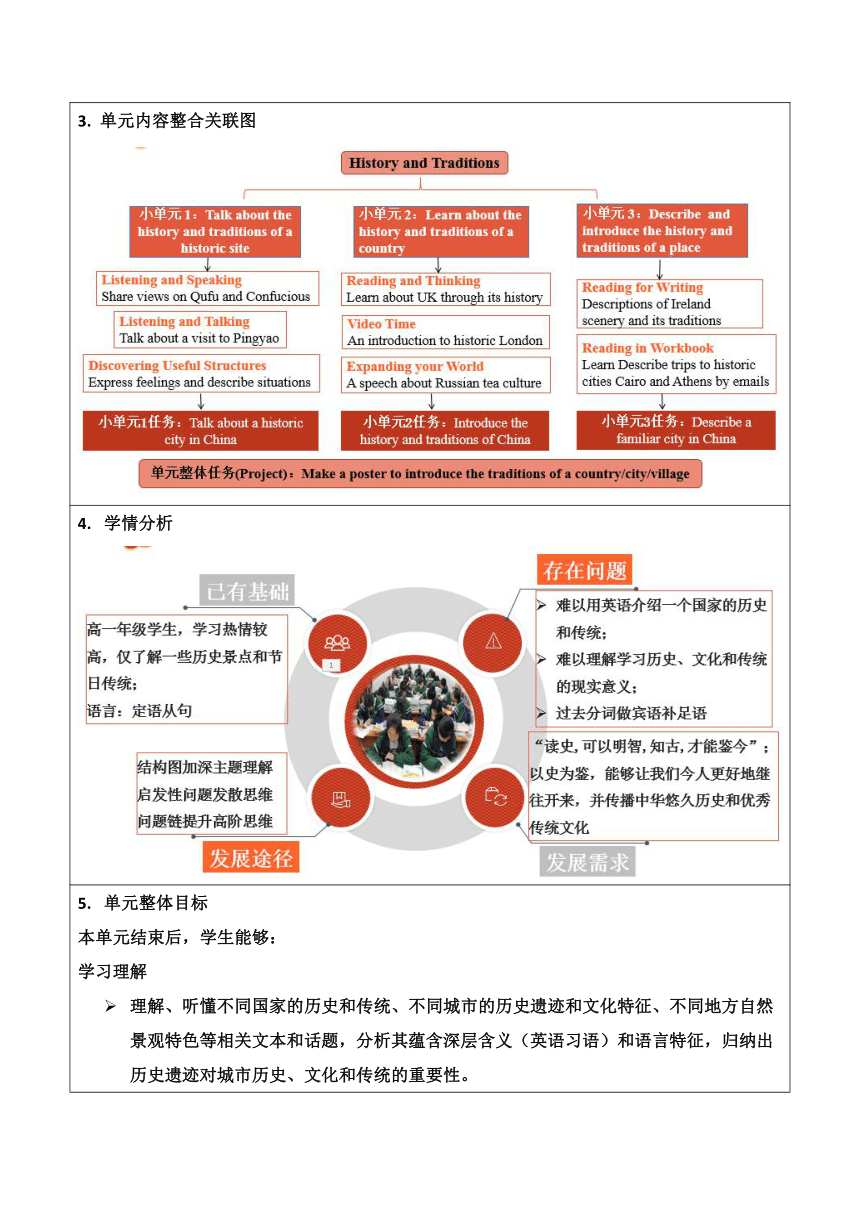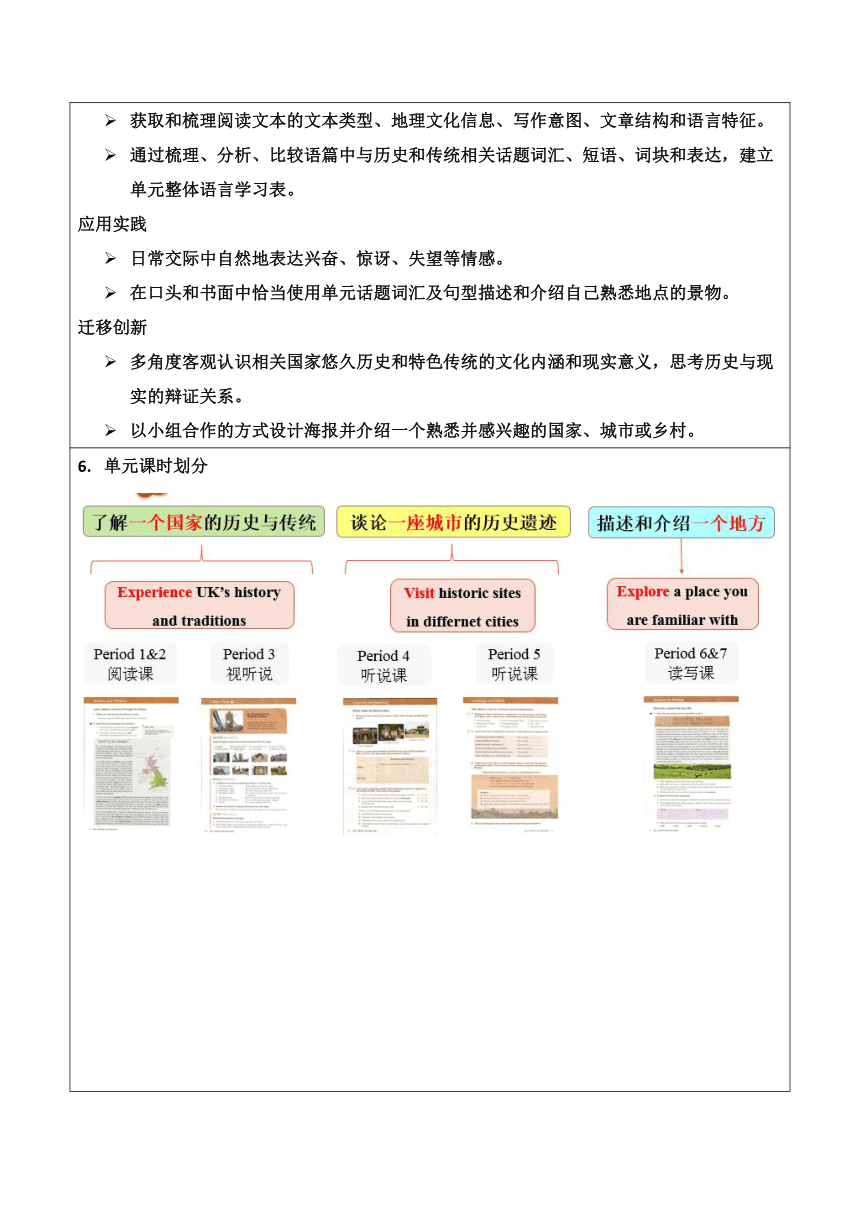人教版(2019)必修 第二册Unit 4 History and traditions单元整体设计(图片版)
文档属性
| 名称 | 人教版(2019)必修 第二册Unit 4 History and traditions单元整体设计(图片版) |  | |
| 格式 | docx | ||
| 文件大小 | 727.7KB | ||
| 资源类型 | 教案 | ||
| 版本资源 | 人教版(2019) | ||
| 科目 | 英语 | ||
| 更新时间 | 2024-03-15 17:29:34 | ||
图片预览





文档简介
教学基本信息
单元名称 Book 2 Unit4
学科 英语 学段 高中 年级 高一第二学期
相关领域
主要教材 书名:普通高中教科书·英语必修第一册 出版社:人民教育出版社
单元教学规划
单元设计指导思想及设计思路 基于主题意义,使学生在知识建构中逐步形成对单元话题的深层认知,提升英语学科核心素养。具体而言,有如下五个步骤: 研读单元各语篇内容,分析主题意义; 将各语篇按主题意义分类,确定单元教学目标; 基于单元教学目标,整合提炼单元主题; 基于单元主题意义重新梳理各语篇,提炼为单元主题意义服务的小单元; 在单元主题意义的指导下,聚焦小单元进行各语篇的教学设计。
单元学习内容、主题教学目标及课时安排 单元主题:人与社会-历史、社会与文化-重大政治、历史事件,文化渊源 人与自然-自然生态-主要国家地理概况、自然环境 “历史与传统”是本单元提炼出来的主题。从主题意义角度出发,本单元以及各课时主题意义探索及教学逻辑如下表所示: What:什么是历史与传统 How:历史与传统通过什么体现 Why:为什么要学习历史与传统 What to do:传播中华悠久历史和优秀传统文化
单元主题意义:了解不同国家的悠久历史和文化传统,理解历史遗迹对一座城市的历史、文化和传统等方面的重要性,探索国内景点的历史文化价值,介绍传播中华悠久历史和优秀传统文化。
3. 单元内容整合关联图
学情分析
单元整体目标 本单元结束后,学生能够: 学习理解 理解、听懂不同国家的历史和传统、不同城市的历史遗迹和文化特征、不同地方自然景观特色等相关文本和话题,分析其蕴含深层含义(英语习语)和语言特征,归纳出历史遗迹对城市历史、文化和传统的重要性。 获取和梳理阅读文本的文本类型、地理文化信息、写作意图、文章结构和语言特征。 通过梳理、分析、比较语篇中与历史和传统相关话题词汇、短语、词块和表达,建立单元整体语言学习表。 应用实践 日常交际中自然地表达兴奋、惊讶、失望等情感。 在口头和书面中恰当使用单元话题词汇及句型描述和介绍自己熟悉地点的景物。 迁移创新 多角度客观认识相关国家悠久历史和特色传统的文化内涵和现实意义,思考历史与现实的辩证关系。 以小组合作的方式设计海报并介绍一个熟悉并感兴趣的国家、城市或乡村。
单元课时划分
设计评价方案
8.教学特色 关注单元内、单元间和教材间的整体设计 强调主题语境下的主题意义 教-学-评一体化
人教新版必修一 Unit 4 History and Traditions教学设计
第1课时 Listening and speaking
Procedures Activities Purposes
Unit quote T introduces the unit quote Lead to the topic and theme
Pre-listening T ask Ss Qs related to Confucius Ss look at the pics and read the brief introduction about“Three Kong” T introduces some key words Activate Ss’ original knowledge about the topic Provide Ss with necessary cultural background Give Ss language support and get them ready for the listening
While-listening Ss predict the contents and are instructed to take down key words Ss fill in the blanks and try to tell the difference between facts and opinions (1)Ss decide whether he sentences are true or false (2)Ss answer a question about the similarity between two speakers’ hometowns and identify the language feature T guides Ss to write down the meaning of the idioms from the dialogue and their Chinese equivalents Listen again Equip Ss with the skills of prediction and note-taking Help Ss distinguish facts from opinions and direct Ss’ attention to different language features Enable Ss to practice listening for detailed information and find out words showing similarity Activate Ss’ own cultural knowledge and encourage cultural comparisons Provide a chance for Ss to practice reading aloud and deepen Ss’ understanding of the whole dialogue
Post-listening Ss reflect on Confucius’ birthplace and historic sites in our city Activate Ss’ own cultural knowledge and encourage sharing of personal experiences
Homework Read the listening material aloud; Finish the language sheet; Prepare an oral presentation about “An introduction of a historic site in my city”. Consolidate the learning effect of this lesson
人教新版必修一 Unit 4 History and Traditions教学设计
第2课时 Listening and talking
Procedures Activities Purposes
Warming up 1. 学生根据自身经历回答问题。 Have you been to Pingyao What is your impression of it Can you name some of the places of interest or historic sites there 2. 教师展示部分景点的照片。 Ming-Qing Street the city wall 激活学生的已知,引出话题。
Listening 1. 学生第一次听对话,并在教材第43页练习1中,勾选对话中提到的地名。 练习1: Ming-Qing Street Rishengchang Bank Shuanglin Temple the city wall 引导学生获取对话主要内容。
2. 学生第二次听对话,获取表达旅行感受的事实性信息,完成教材第43页练习2。 How did Paul and Xiao Yan feel 3. 推断对话中的人物对旅行的感受。 4. 学生听对话片段,感受语气在对话中的重要作用。 引导学生关注对话中表达旅行感受的话语,并推断人物的感受。
Reading aloud & Thinking 学生朗读对话,体会表示惊讶、失望、惊喜等情感的表达方式,并思考和总结对话中所包含的有关平遥的信息。 What were mentioned when they talked about Pingyao 操练语言,概括与总结对话的主要内容。
Role-play 学生完成教材43页练习3,进行角色扮演。假设刚从平遥旅行归来,学生两人一组分享平遥旅行经历及感受。 学生可以参考教材43页练习3所给的表示情感的句式。 I had no idea… I didn’t know… I was eager/surprised to see/learn/hear that… It was so much fun! It was a little disappointing. It wasn’t as good/interesting/fun as I’d expected. 学生通过角色扮演,巩固复习对话内容,学习使用表达旅行感受到的词句。
Talking 1. 教师针对如何介绍自己的历史名胜旅游经历给出建议和示范。 Step 1 Decide a historic place you want to talk about. Step 2 List the aspects you will talk about. Step 3 Remember to express your feelings. 2. 学生完成教材43页练习4。用本节课所学知识介绍自己曾经参观过的一处历史遗迹。 学生通过介绍自己参观过的一处历史遗迹,学习如何分享旅行经历及旅行感受,巩固本节课所学内容。
人教新版必修一 Unit 4 History and Traditions教学设计
第3-4课时 Reading and thinking
教学目标 活动形式与步骤 活动意图 活动层次 学习效果评价 时间
Teacher introduces the learning objectives of this lesson. 让学生全面了解学习目标 学生对学习目标做到心中有数 2
获取地图信息和梳理英国的历史、地理和文化等基本信息。 Step 1: Lead-in Activity 1: Show News on Queen Elizabeth II’s death and predict where she was from Students will be attracted to learn about the different names of UK. Activity 2: Read a map Do you know the full name of this country What does the map show What do the different symbols and colors stand for How many parts make up the UK What are they 联系学生熟知新闻,创设主题语境,激发学生对英国历史的兴趣。并引入本节课新词,如 United Kingdom, Wales等与话题相关的词汇。 渗透读地图的阅读策略,引入本节课话题。 感知与注意A1 获取和梳理A2 学生激活已有知识和经验,唤起对英国名称及历史的印象; 在指导下学生能够正确读地图 10
Step 2 Reading 1. Prediction 2. Read for main idea Scan the text, underline key words and sentences of each paragraph and summarize the main idea of each paragraph. Read for details Para.2 In what order is this paragraph organized Read again and sort out the information according to timeline Para.3 How does the writer develop this paragraph What are the similarities and differences of these countries Para.4 What changes did the four groups of people make in the UK Read again and sort out the information according to timeline Para.5 Why is London a great place to start What is the writer’s impression on UK Is there any advice the writer give you when visiting the UK 4. Read the passage aloud 教师介绍文章标题,学生根据标题及地图预测文章内容。 学生根据时间轴复述英国的历史。 基于主题,引导学生梳理和整合四个国家的相同点和不同点。引导学生关注文章结构。 引导学生关注文章中的重要语言点。 获取与梳理A2 推理与论证 C1 学生通读全文,梳理文章大意,检验预测。 学生关注文章中的重要语言点。 学生进一步内化文本信息 28
Step3. Post-reading Activity 1 Discuss the following question: What do you think is the meaning of understanding Chinese history Which part of history do you want to know most during Chinese five thousand years Which city would you recommend to your foreign friends Why Activity 2 Presentation & Assessment 学生基于阅读中获取的信息发表自己的看法。引导学生感受异国文化,增强文化意识,培养跨文化理解的能力 分析与判断B2 内化与运用B3 学生具有较强的合作意识和表达欲望,能从不同角度发散思维。 15 25 25
Step5:Homework 1. Read the text aloud and finish the vocabulary-building chart; 2. Write a short passage to introduce the history of the UK with the help of the timeline; 3. Polish your presentation according to the assessment 完善自己的写作,巩固本课所学。 内化与运用B3 学生进一步思考学习历史和文化的重要性。 2
人教新版必修一 Unit 4 History and Traditions教学设计
第5-6课时 Reading for writing
教学目标 活动形式与步骤 活动意图 活动层次 学习效果评价
Teacher introduces the learning objectives of this lesson. 让学生全面了解学习目标 学生对学习目标做到心中有数
获取有关爱尔兰的事实性信息 Step 1: Lead-in Activity 1: Show Ireland’s map, and then enjoy a short video Students will be asked to learn about Ireland’s background and enjoy a short video about Ireland scenery. Activity 2:Free talk: What’s your impression of Ireland’s countryside 从学生实际出发,创设主题语境,激发学生对爱尔兰乡村的兴趣;视听材料作为课前热身,能快速让学生融入主题语境。 感知与注意A1 学生激活已有知识和经验,唤起对自己生活居住地景象的印象
获取有关爱尔兰的事实性信息 梳理文章结构,并获取和欣赏文章中使用五感描写的语言 Step 2 Reading 1. Read for main idea. 2. Read for basic information What makes the Irish countryside exciting and inspiring What are the best ways to experience some Irish traditions and culture 3. Read for structure 4. Read for details 5. Appreciate language 6. Summary 7. Descriptive phrases 8. Read the passage aloud 引导学生获取有关爱尔兰的事实性信息,梳理文章从哪几方面介绍了爱尔兰。 引导学生关注文中描述性的语言,学习如何丰富内容及语言。 获取与梳理A2 推理与论证 C1 学生能关注到该段落的“总-分-总”结构,理清主旨大意。 学生知道景物描写的“五感写作法(sight,hearing,smell,touch,taste )” 。并关注到一些修辞手法的运用。 进一步内化文本信息
仿写一篇描述自己喜欢的地方的文章 完善自己的写作借助五感法和原文句式 Step3. Apply what they’ve learned to write a new descriptive paragraph Activity 1 Discuss the following question: What’s your favourite city Why do you think it is interesting, exciting, or surprising What are the best ways to experience its traditions and customs (groups) Activity 2 Teacher leads Ss to finish a writing according to the following question and the sentence patterns. What can you see What can you hear How does the place feel What can you smell What can you taste there What does the place make you think or feel Activity 3 Students finish their own writing based on what they have learned. 通过讨论进一步引导学生从口头到笔头的形式,介绍一个自己喜欢的地方。学生需要关注文章结构及使用描述性的语言丰富文章。 通过语言输出加深对文本的理解。 分析与判断B2 内化与运用B3 想象与创造C3 学生具有较强的合作意识和表达欲望,能从不同角度发散思维。 将“五感写作法(sight,hearing,smell,touch,taste )”进行应用 学生能通过文章信息的梳理能进一步将所学迁移到新的情境。
Step4: Evaluate the writing according to the checklist. 引导学生开展自评、互评活动以更好地内化本篇所学。 批判与评级C2 学生能够在checklist和教师的指导下公正客观地评价自己及他人的写作
Step5:Homework Polish your draft. Turn to WB P83, finish the task 4. 完善自己的写作,巩固本课所学。 内化与运用B3 通过内化所学,感受景物描写的细腻,探究本单元的主题意义,深入思考历史与传统的价值。
单元名称 Book 2 Unit4
学科 英语 学段 高中 年级 高一第二学期
相关领域
主要教材 书名:普通高中教科书·英语必修第一册 出版社:人民教育出版社
单元教学规划
单元设计指导思想及设计思路 基于主题意义,使学生在知识建构中逐步形成对单元话题的深层认知,提升英语学科核心素养。具体而言,有如下五个步骤: 研读单元各语篇内容,分析主题意义; 将各语篇按主题意义分类,确定单元教学目标; 基于单元教学目标,整合提炼单元主题; 基于单元主题意义重新梳理各语篇,提炼为单元主题意义服务的小单元; 在单元主题意义的指导下,聚焦小单元进行各语篇的教学设计。
单元学习内容、主题教学目标及课时安排 单元主题:人与社会-历史、社会与文化-重大政治、历史事件,文化渊源 人与自然-自然生态-主要国家地理概况、自然环境 “历史与传统”是本单元提炼出来的主题。从主题意义角度出发,本单元以及各课时主题意义探索及教学逻辑如下表所示: What:什么是历史与传统 How:历史与传统通过什么体现 Why:为什么要学习历史与传统 What to do:传播中华悠久历史和优秀传统文化
单元主题意义:了解不同国家的悠久历史和文化传统,理解历史遗迹对一座城市的历史、文化和传统等方面的重要性,探索国内景点的历史文化价值,介绍传播中华悠久历史和优秀传统文化。
3. 单元内容整合关联图
学情分析
单元整体目标 本单元结束后,学生能够: 学习理解 理解、听懂不同国家的历史和传统、不同城市的历史遗迹和文化特征、不同地方自然景观特色等相关文本和话题,分析其蕴含深层含义(英语习语)和语言特征,归纳出历史遗迹对城市历史、文化和传统的重要性。 获取和梳理阅读文本的文本类型、地理文化信息、写作意图、文章结构和语言特征。 通过梳理、分析、比较语篇中与历史和传统相关话题词汇、短语、词块和表达,建立单元整体语言学习表。 应用实践 日常交际中自然地表达兴奋、惊讶、失望等情感。 在口头和书面中恰当使用单元话题词汇及句型描述和介绍自己熟悉地点的景物。 迁移创新 多角度客观认识相关国家悠久历史和特色传统的文化内涵和现实意义,思考历史与现实的辩证关系。 以小组合作的方式设计海报并介绍一个熟悉并感兴趣的国家、城市或乡村。
单元课时划分
设计评价方案
8.教学特色 关注单元内、单元间和教材间的整体设计 强调主题语境下的主题意义 教-学-评一体化
人教新版必修一 Unit 4 History and Traditions教学设计
第1课时 Listening and speaking
Procedures Activities Purposes
Unit quote T introduces the unit quote Lead to the topic and theme
Pre-listening T ask Ss Qs related to Confucius Ss look at the pics and read the brief introduction about“Three Kong” T introduces some key words Activate Ss’ original knowledge about the topic Provide Ss with necessary cultural background Give Ss language support and get them ready for the listening
While-listening Ss predict the contents and are instructed to take down key words Ss fill in the blanks and try to tell the difference between facts and opinions (1)Ss decide whether he sentences are true or false (2)Ss answer a question about the similarity between two speakers’ hometowns and identify the language feature T guides Ss to write down the meaning of the idioms from the dialogue and their Chinese equivalents Listen again Equip Ss with the skills of prediction and note-taking Help Ss distinguish facts from opinions and direct Ss’ attention to different language features Enable Ss to practice listening for detailed information and find out words showing similarity Activate Ss’ own cultural knowledge and encourage cultural comparisons Provide a chance for Ss to practice reading aloud and deepen Ss’ understanding of the whole dialogue
Post-listening Ss reflect on Confucius’ birthplace and historic sites in our city Activate Ss’ own cultural knowledge and encourage sharing of personal experiences
Homework Read the listening material aloud; Finish the language sheet; Prepare an oral presentation about “An introduction of a historic site in my city”. Consolidate the learning effect of this lesson
人教新版必修一 Unit 4 History and Traditions教学设计
第2课时 Listening and talking
Procedures Activities Purposes
Warming up 1. 学生根据自身经历回答问题。 Have you been to Pingyao What is your impression of it Can you name some of the places of interest or historic sites there 2. 教师展示部分景点的照片。 Ming-Qing Street the city wall 激活学生的已知,引出话题。
Listening 1. 学生第一次听对话,并在教材第43页练习1中,勾选对话中提到的地名。 练习1: Ming-Qing Street Rishengchang Bank Shuanglin Temple the city wall 引导学生获取对话主要内容。
2. 学生第二次听对话,获取表达旅行感受的事实性信息,完成教材第43页练习2。 How did Paul and Xiao Yan feel 3. 推断对话中的人物对旅行的感受。 4. 学生听对话片段,感受语气在对话中的重要作用。 引导学生关注对话中表达旅行感受的话语,并推断人物的感受。
Reading aloud & Thinking 学生朗读对话,体会表示惊讶、失望、惊喜等情感的表达方式,并思考和总结对话中所包含的有关平遥的信息。 What were mentioned when they talked about Pingyao 操练语言,概括与总结对话的主要内容。
Role-play 学生完成教材43页练习3,进行角色扮演。假设刚从平遥旅行归来,学生两人一组分享平遥旅行经历及感受。 学生可以参考教材43页练习3所给的表示情感的句式。 I had no idea… I didn’t know… I was eager/surprised to see/learn/hear that… It was so much fun! It was a little disappointing. It wasn’t as good/interesting/fun as I’d expected. 学生通过角色扮演,巩固复习对话内容,学习使用表达旅行感受到的词句。
Talking 1. 教师针对如何介绍自己的历史名胜旅游经历给出建议和示范。 Step 1 Decide a historic place you want to talk about. Step 2 List the aspects you will talk about. Step 3 Remember to express your feelings. 2. 学生完成教材43页练习4。用本节课所学知识介绍自己曾经参观过的一处历史遗迹。 学生通过介绍自己参观过的一处历史遗迹,学习如何分享旅行经历及旅行感受,巩固本节课所学内容。
人教新版必修一 Unit 4 History and Traditions教学设计
第3-4课时 Reading and thinking
教学目标 活动形式与步骤 活动意图 活动层次 学习效果评价 时间
Teacher introduces the learning objectives of this lesson. 让学生全面了解学习目标 学生对学习目标做到心中有数 2
获取地图信息和梳理英国的历史、地理和文化等基本信息。 Step 1: Lead-in Activity 1: Show News on Queen Elizabeth II’s death and predict where she was from Students will be attracted to learn about the different names of UK. Activity 2: Read a map Do you know the full name of this country What does the map show What do the different symbols and colors stand for How many parts make up the UK What are they 联系学生熟知新闻,创设主题语境,激发学生对英国历史的兴趣。并引入本节课新词,如 United Kingdom, Wales等与话题相关的词汇。 渗透读地图的阅读策略,引入本节课话题。 感知与注意A1 获取和梳理A2 学生激活已有知识和经验,唤起对英国名称及历史的印象; 在指导下学生能够正确读地图 10
Step 2 Reading 1. Prediction 2. Read for main idea Scan the text, underline key words and sentences of each paragraph and summarize the main idea of each paragraph. Read for details Para.2 In what order is this paragraph organized Read again and sort out the information according to timeline Para.3 How does the writer develop this paragraph What are the similarities and differences of these countries Para.4 What changes did the four groups of people make in the UK Read again and sort out the information according to timeline Para.5 Why is London a great place to start What is the writer’s impression on UK Is there any advice the writer give you when visiting the UK 4. Read the passage aloud 教师介绍文章标题,学生根据标题及地图预测文章内容。 学生根据时间轴复述英国的历史。 基于主题,引导学生梳理和整合四个国家的相同点和不同点。引导学生关注文章结构。 引导学生关注文章中的重要语言点。 获取与梳理A2 推理与论证 C1 学生通读全文,梳理文章大意,检验预测。 学生关注文章中的重要语言点。 学生进一步内化文本信息 28
Step3. Post-reading Activity 1 Discuss the following question: What do you think is the meaning of understanding Chinese history Which part of history do you want to know most during Chinese five thousand years Which city would you recommend to your foreign friends Why Activity 2 Presentation & Assessment 学生基于阅读中获取的信息发表自己的看法。引导学生感受异国文化,增强文化意识,培养跨文化理解的能力 分析与判断B2 内化与运用B3 学生具有较强的合作意识和表达欲望,能从不同角度发散思维。 15 25 25
Step5:Homework 1. Read the text aloud and finish the vocabulary-building chart; 2. Write a short passage to introduce the history of the UK with the help of the timeline; 3. Polish your presentation according to the assessment 完善自己的写作,巩固本课所学。 内化与运用B3 学生进一步思考学习历史和文化的重要性。 2
人教新版必修一 Unit 4 History and Traditions教学设计
第5-6课时 Reading for writing
教学目标 活动形式与步骤 活动意图 活动层次 学习效果评价
Teacher introduces the learning objectives of this lesson. 让学生全面了解学习目标 学生对学习目标做到心中有数
获取有关爱尔兰的事实性信息 Step 1: Lead-in Activity 1: Show Ireland’s map, and then enjoy a short video Students will be asked to learn about Ireland’s background and enjoy a short video about Ireland scenery. Activity 2:Free talk: What’s your impression of Ireland’s countryside 从学生实际出发,创设主题语境,激发学生对爱尔兰乡村的兴趣;视听材料作为课前热身,能快速让学生融入主题语境。 感知与注意A1 学生激活已有知识和经验,唤起对自己生活居住地景象的印象
获取有关爱尔兰的事实性信息 梳理文章结构,并获取和欣赏文章中使用五感描写的语言 Step 2 Reading 1. Read for main idea. 2. Read for basic information What makes the Irish countryside exciting and inspiring What are the best ways to experience some Irish traditions and culture 3. Read for structure 4. Read for details 5. Appreciate language 6. Summary 7. Descriptive phrases 8. Read the passage aloud 引导学生获取有关爱尔兰的事实性信息,梳理文章从哪几方面介绍了爱尔兰。 引导学生关注文中描述性的语言,学习如何丰富内容及语言。 获取与梳理A2 推理与论证 C1 学生能关注到该段落的“总-分-总”结构,理清主旨大意。 学生知道景物描写的“五感写作法(sight,hearing,smell,touch,taste )” 。并关注到一些修辞手法的运用。 进一步内化文本信息
仿写一篇描述自己喜欢的地方的文章 完善自己的写作借助五感法和原文句式 Step3. Apply what they’ve learned to write a new descriptive paragraph Activity 1 Discuss the following question: What’s your favourite city Why do you think it is interesting, exciting, or surprising What are the best ways to experience its traditions and customs (groups) Activity 2 Teacher leads Ss to finish a writing according to the following question and the sentence patterns. What can you see What can you hear How does the place feel What can you smell What can you taste there What does the place make you think or feel Activity 3 Students finish their own writing based on what they have learned. 通过讨论进一步引导学生从口头到笔头的形式,介绍一个自己喜欢的地方。学生需要关注文章结构及使用描述性的语言丰富文章。 通过语言输出加深对文本的理解。 分析与判断B2 内化与运用B3 想象与创造C3 学生具有较强的合作意识和表达欲望,能从不同角度发散思维。 将“五感写作法(sight,hearing,smell,touch,taste )”进行应用 学生能通过文章信息的梳理能进一步将所学迁移到新的情境。
Step4: Evaluate the writing according to the checklist. 引导学生开展自评、互评活动以更好地内化本篇所学。 批判与评级C2 学生能够在checklist和教师的指导下公正客观地评价自己及他人的写作
Step5:Homework Polish your draft. Turn to WB P83, finish the task 4. 完善自己的写作,巩固本课所学。 内化与运用B3 通过内化所学,感受景物描写的细腻,探究本单元的主题意义,深入思考历史与传统的价值。
